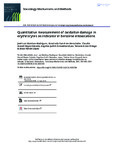
Please use this identifier to cite or link to this item:
http://ricaxcan.uaz.edu.mx/jspui/handle/20.500.11845/589| Title: | Quantitative measurement of oxidative damage in erythrocytes as indicator in benzene intoxications |
| Other Titles: | Quantitative measurement of oxidative damage in erythrocytes as indicator in benzene intoxications |
| Authors: | Martínez Rodríguez, José Luis Reyes Estrada, Claudia Araceli Arcos Ortega, Leidy Tatiana Gutiérrez Hernández, Rosalinda Granados López, Angelica Judith López, Jesús Adrián |
| Issue Date: | 12-Apr-2018 |
| Publisher: | Taylor & Francis Group |
| Abstract: | The metabolism of aromatic hydrocarbons by the organism forms products that cause cell death depending on the type of exposure. Benzene exposure has been linked to oxidative stress, hepatic damage, aplastic anemia, and hematopoietic cancer as lymphoid and myeloid leukemia. However, there are not fast methods to evaluate chronic benzene exposure in human blood. The objective of this work was the evaluation of the correlation between oxidative damage with benzene exposure and the level of cellular plasma membrane stability (CPMS) in erythrocytes to use it as a future indicator to determine the grade of benzene intoxications. CPMS in vitro assays were used to evaluate damage for benzene, toluene, and xylene. Erythrocytes CPMS assays in vitro shows a progressive reduction with benzene, toluene, and xylene suggesting that aromatic hydrocarbons complexity favors CPMS damage. Eight groups of Wistar rats (n¼5) were used to study the level of damage on CPMS by acute and chronic benzene administration. Enzymatic, metabolic, histological, and oxidative damage tests were performed. Acute administration (100lL/100g/single dose) showed a decrease of 66.7% in CPMS, while 63.6% for chronic administration (5lL/100g/every 2days/3months) showing a correlation with liver damage principally (transaminases activity increase, glycogen level decrease, and high oxidative damage). Tissue damage was observed in bone marrow, kidney, spleen, and lungs. Benzene produces damage on CPMS depending on the exposure time and dose. The CPMS technique could be used as an important aromatic hydrocarbons intoxication indicator. |
| Description: | The metabolism of aromatic hydrocarbons by the organism forms products that cause cell death depending on the type of exposure. Benzene exposure has been linked to oxidative stress, hepatic damage, aplastic anemia, and hematopoietic cancer as lymphoid and myeloid leukemia. However, there are not fast methods to evaluate chronic benzene exposure in human blood. The objective of this work was the evaluation of the correlation between oxidative damage with benzene exposure and the level of cellular plasma membrane stability (CPMS) in erythrocytes to use it as a future indicator to determine the grade of benzene intoxications. CPMS in vitro assays were used to evaluate damage for benzene, toluene, and xylene. Erythrocytes CPMS assays in vitro shows a progressive reduction with benzene, toluene, and xylene suggesting that aromatic hydrocarbons complexity favors CPMS damage. Eight groups of Wistar rats (n¼5) were used to study the level of damage on CPMS by acute and chronic benzene administration. Enzymatic, metabolic, histological, and oxidative damage tests were performed. Acute administration (100lL/100g/single dose) showed a decrease of 66.7% in CPMS, while 63.6% for chronic administration (5lL/100g/every 2days/3months) showing a correlation with liver damage principally (transaminases activity increase, glycogen level decrease, and high oxidative damage). Tissue damage was observed in bone marrow, kidney, spleen, and lungs. Benzene produces damage on CPMS depending on the exposure time and dose. The CPMS technique could be used as an important aromatic hydrocarbons intoxication indicator. |
| URI: | http://hdl.handle.net/20.500.11845/589 https://doi.org/10.48779/z7n0-mr76 |
| ISSN: | 1537-6516 1537-6524 |
| Other Identifiers: | info:eu-repo/semantics/publishedVersion |
| Appears in Collections: | *Documentos Académicos*-- UA Medicina |
Files in This Item:
| File | Description | Size | Format | |
|---|---|---|---|---|
| Quantitative measurement of oxidative damage in erythrocytes as indicator in benzene intoxications.pdf | 3,94 MB | Adobe PDF |  View/Open |
This item is licensed under a Creative Commons License
